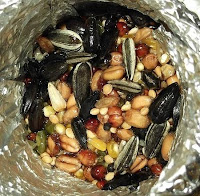Don't Forget to Feed the Garden Birds
 As temperatures plummet and the prospect of another long winter draws in, it's time to check our wild bird supplies. Seeds, nuts, berries, fruit and suet are all firm favourites, as is a bit of cheap cat food. (Mealworms are a treat few frugalers can afford, hence the cat food.)
As temperatures plummet and the prospect of another long winter draws in, it's time to check our wild bird supplies. Seeds, nuts, berries, fruit and suet are all firm favourites, as is a bit of cheap cat food. (Mealworms are a treat few frugalers can afford, hence the cat food.)Frugal living may be based on a very tight budget but the 'waste not, want not' in all of us can usually stretch to helping the wildlife on our own back doorsteps.
 Here in Frugaldom, we have an assortment of feeding stations dotted about the garden, mostly of the homemade variety. (This is my logman feeding station, he's made from part of a felled conifer tree and some bottle tops for eyes and nose.)
Here in Frugaldom, we have an assortment of feeding stations dotted about the garden, mostly of the homemade variety. (This is my logman feeding station, he's made from part of a felled conifer tree and some bottle tops for eyes and nose.)I buy wild bird food by the 20kg bag from the local agricultural merchant and have it delivered along with the poultry feeding, so it's available all year round. Otherwise, anything left over that's suitable gets put out on the tables.
 The Bluetits love peanuts and fat-balls, but we need to remember to remove these from their net bags to avoid the birds catching beaks, tongues or claws in them. The Robins eat almost anything, the Coal Tits love peanuts and the list could go on and on and on. In fact, wild birds could eat us out of house and home here, so I try to make feed last as long as possible and as interesting as possible.
The Bluetits love peanuts and fat-balls, but we need to remember to remove these from their net bags to avoid the birds catching beaks, tongues or claws in them. The Robins eat almost anything, the Coal Tits love peanuts and the list could go on and on and on. In fact, wild birds could eat us out of house and home here, so I try to make feed last as long as possible and as interesting as possible.Peanuts in shells (leftovers from Halloween, perhaps?) are great for stringing together and hanging in hedges or trees - the bluetits quite happily dangle there, pecking away at the shells and feeding on the kernels. There's also a cheap way of making the fatty treats the birds all seem to love.

I have an empty herb tub that I line with tin foil - you'll see just shortly why it has to be lined. Into this, I put a couple of handfuls of mixed wildbird feed in plus any seeds, crumbs, sultanas etc that have been left aside for any reason. As long as your tub is at the ready, you can tip in the hot fat anytime you fry.
Having bought several tins of sausages from ROSSPA, they come canned in lard, which is great for making the feed blocks as it sets hard quite quickly. You can also set the seed, fruit and nut mix inside half coconut shells and then hand these from trees or posts. The other thing you can do is place string (non-nylon) in the middle of the seed blocks then tie them up once the fat has set hard.
 To speed up the process, you can pop the cooled blocks into your fridge or freezer. Obviously, if you live in freezing northern parts of the country, you'll find it's cold enough outside to set the feed blocks hard. This is one I have setting now, after having fried up a tin of sausages to add to a little chilli I had leftover - it meant it fed two of us instead of just one.
To speed up the process, you can pop the cooled blocks into your fridge or freezer. Obviously, if you live in freezing northern parts of the country, you'll find it's cold enough outside to set the feed blocks hard. This is one I have setting now, after having fried up a tin of sausages to add to a little chilli I had leftover - it meant it fed two of us instead of just one. During the hardest of winters, it's also a good idea to provide a daily supply of water, as most of what's around will be frozen. The starlings will probably bath in it, but if that's what they want to do, who are we to say otherwise.
Now all I need to do is try my best to keep everything out of reach of Scruffy cat, which means hanging it up high enough that she can't climb or leap up and grab the birds!
Frugaldom
www.frugaldom.com

we have a lovely variety of birds around here, which I like to feed.
ReplyDeleteGill
I used to have bird feeders all over the place but the pigeons and collared doves took over. Now we have one small feeder that only small birds can access plus a hanging feeder of nuts that bigger birds can access but not the pigeons etc. Unfortunately this means the blackbirds usually miss out but my neighbour feeds them scraps so hopefully, they get something.
ReplyDeleteI have mealworms, peanuts, water and bird seed on my lovely bird table that I got because the parents were upgrading, but my garden birds don't seem to have found it yet because they prefer to eat of the floor. We must have a lot of insects type thingies down there.
ReplyDelete